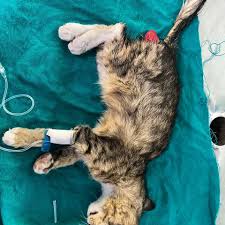What Is Rectal Prolapse in Kittens?
Rectal prolapse in kittens, while alarming to witness, is a condition where the inner lining of the rectum protrudes through the anus. It appears as a red, moist, and often cylindrical mass extending from the kitten’s bottom. While it can occur in cats of any age, it’s more commonly seen in young kittens due to their less developed pelvic muscles and increased susceptibility to conditions that strain the rectum. Understanding the causes, symptoms, and treatment options is crucial for any kitten owner to ensure a swift and successful recovery for their feline friend.
Causes of Rectal Prolapse in Kittens
Several factors can contribute to rectal prolapse in kittens. Identifying the underlying cause is essential for effective treatment and prevention of recurrence. Some of the most common culprits include:
-
Parasitic Infections: Intestinal parasites, such as roundworms, hookworms, and whipworms, are a frequent cause, especially in young kittens. These parasites irritate the intestinal lining, leading to diarrhea and straining during defecation, which can force the rectum outwards.
-
Severe Diarrhea: Diarrhea, regardless of the cause (dietary indiscretion, infection, or other underlying health issues), can lead to frequent and forceful bowel movements, putting excessive pressure on the rectum.
-
Constipation: Paradoxically, constipation can also cause rectal prolapse. When a kitten strains excessively to pass hard, dry stools, it can weaken the rectal muscles and lead to prolapse.
-
Malnutrition: Kittens suffering from malnutrition may have weakened muscles and tissues, making them more susceptible to rectal prolapse.
-
Birth Defects: In some cases, congenital abnormalities in the rectum or anus can predispose a kitten to prolapse.
-
Perineal Hernias: Although less common in kittens than in older animals, a perineal hernia (a weakening of the muscles in the perineum) can allow abdominal contents, including the rectum, to protrude.
-
Intussusception: This occurs when one part of the intestine telescopes into another, causing a blockage and straining.
Recognizing the Signs: Symptoms to Watch For
The most obvious sign of rectal prolapse is the visible protrusion of a red, moist mass from the anus. However, other symptoms may accompany the prolapse, including:
-
Straining to Defecate: The kitten may exhibit signs of discomfort and strain excessively when attempting to pass stool.
-
Diarrhea or Constipation: As mentioned earlier, both diarrhea and constipation can be underlying causes and may be present alongside the prolapse.
-
Blood in Stool: The prolapsed tissue is delicate and prone to bleeding, so you may notice blood in the kitten’s stool or around the anus.
-
Licking or Grooming the Anal Area Excessively: The kitten may lick or groom the affected area excessively due to discomfort and irritation.
-
Lethargy and Loss of Appetite: If the prolapse is severe or accompanied by other health issues, the kitten may become lethargic and lose its appetite.
Diagnosis and Treatment Options
If you suspect your kitten has a rectal prolapse, it’s crucial to seek veterinary attention immediately. The veterinarian will perform a physical examination to assess the severity of the prolapse and look for any underlying causes. They may also recommend diagnostic tests, such as:
-
Fecal Examination: To check for intestinal parasites.
-
Blood Tests: To evaluate the kitten’s overall health and rule out other underlying conditions.
-
Radiographs (X-rays): To look for intestinal blockages or other abnormalities.
Treatment for rectal prolapse in kittens depends on the severity of the prolapse and the underlying cause. Options include:
-
Manual Reduction: In mild cases, the veterinarian may be able to gently push the prolapsed tissue back into place. This is usually done under sedation or anesthesia. A purse-string suture may be placed around the anus to temporarily prevent recurrence.
-
Surgical Repair: In more severe cases, or if the prolapse recurs, surgery may be necessary. The veterinarian may perform a colopexy (attaching the colon to the abdominal wall) or a rectal resection (removing the damaged portion of the rectum).
-
Addressing the Underlying Cause: It’s crucial to treat the underlying cause of the prolapse, such as deworming for parasitic infections or managing diarrhea with medication and dietary changes.
-
Supportive Care: Supportive care, such as providing a bland diet, ensuring adequate hydration, and administering pain medication, is essential for the kitten’s recovery.
Prevention is Key
While not all cases of rectal prolapse can be prevented, there are steps you can take to minimize the risk:
-
Regular Deworming: Keep your kitten on a regular deworming schedule to prevent parasitic infections.
-
Proper Diet: Feed your kitten a high-quality, balanced diet to support healthy digestion.
-
Prompt Veterinary Care: Seek veterinary attention promptly for any signs of diarrhea, constipation, or other health problems.
-
Hygiene: Maintain good hygiene in the kitten’s living environment to prevent the spread of infections.
Rectal prolapse in kittens can be a distressing condition, but with prompt veterinary care and appropriate treatment, most kittens make a full recovery. By understanding the causes, symptoms, and treatment options, you can help your feline companion get back on the path to health and happiness. Remember to always consult with your veterinarian for any health concerns regarding your kitten.

